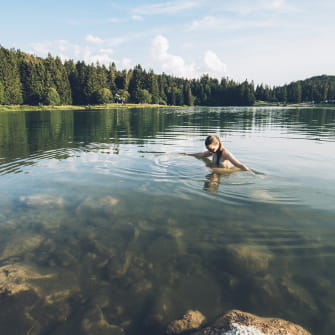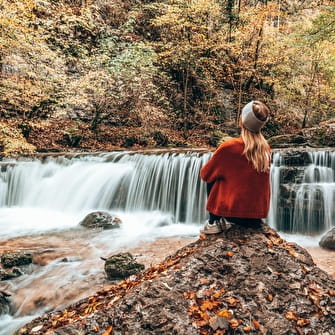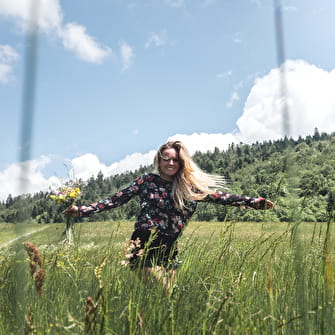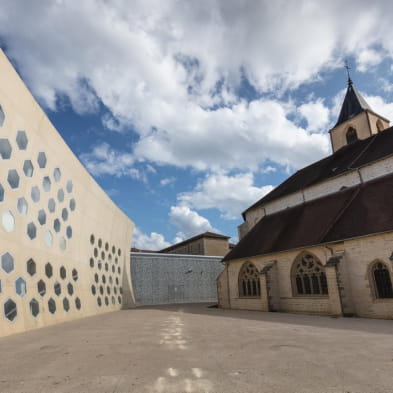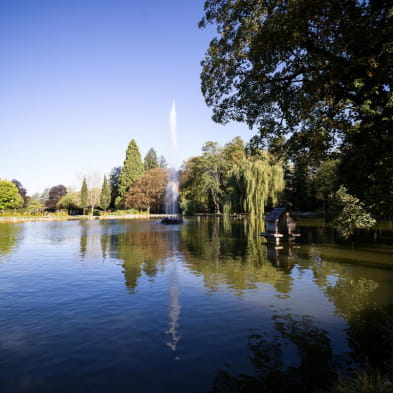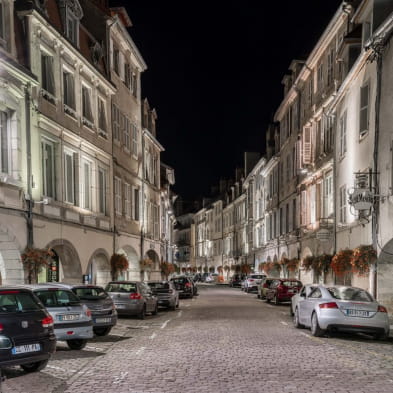- 03 84 24 65 01
- https://www.lons-jura.fr/
- View email address
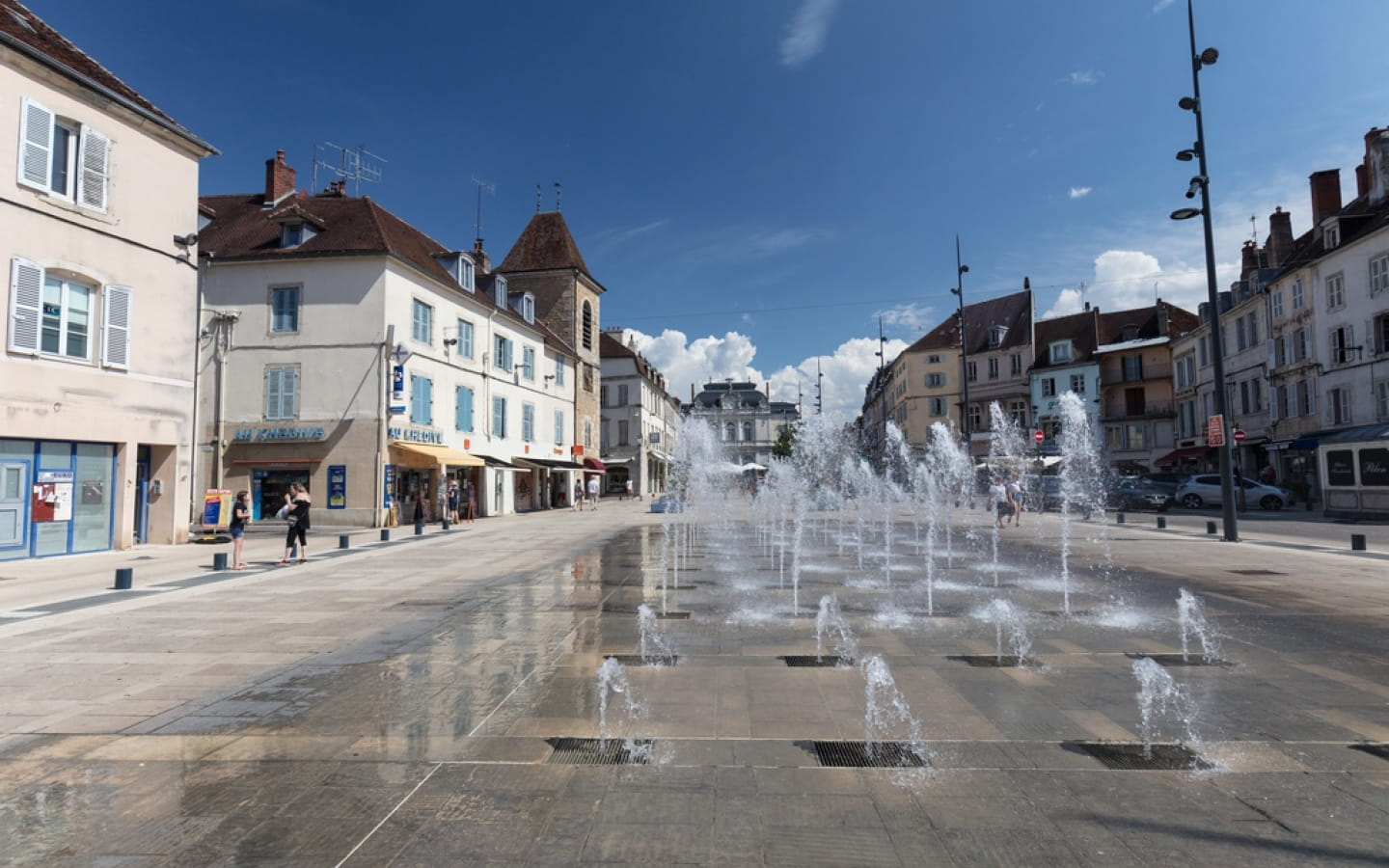
Discover Old Lons
Stroll through the old town of Lons to discover the town's heritage.
1 The Theatre
The theatre occupies a prime position in Lons-le-Saunier, and its facades punctuate two lively squares in the town centre: Place de la Liberté and Place du 11 Novembre. It is a beautiful Rococo building, rebuilt in 1901 after a violent fire. The village hall, which occupied half the building, was also destroyed by fire in 1983. Now rebuilt, it has been transformed into a conference and meeting centre, known as CAR'COM, offering a wide range of facilities. The theatre is a masterpiece of early twentieth-century architecture, where gilding, red velvet, paint and stucco combine to give the auditorium all its splendour. This listed building was restored in 1997.
2 The rue Perrin fountain
This is undoubtedly the most characteristic of Lédon's fountains, and also the oldest. Built against this house in 1727, it was previously located elsewhere, perhaps at the end of the impasse Saint Roch (now rue Perrin), or at the corner of rue des Cordeliers on the rue du Four side. Restored a few years ago, it symbolises the twofold aim of enhancing the town's old quarters and reintroducing water to Lédon's fountains (a few years ago, the Swan Fountain was returned to its original position in front of the Car'Com).
The
3 The Cordeliers church
It's a discreet monument, hidden away at the end of a small courtyard, itself enclosed by a splendid 15th-century porch. But it is a magnificent church, originally built in the 13th century and which, as a result of numerous fires, now essentially dates from the 18th century (particularly its Jesuit-style façade, completed in 1731).
Inside, there are three sets of furniture listed as Historic Monuments: the pulpit (1728, the work of Lédonian cabinet-makers Lamberthoz), the great organs (circa 1845, Callinet organs) and the choir stalls (circa 1828, late Louis XVI style).
A crypt, now inaccessible, is the burial place of the Chalon family, powerful lords of the town in the Middle Ages.
4 The Place de la Comédie
This pretty, southern-coloured square was restored as part of an O.P.A.H. project between 1980 and 1985. It owes its name to a small theatre (a disused church transformed into a theatre during the French Revolution) that has now been destroyed. In fact, it was a working-class wine-growing district. The lintels of some doors still bear the emblem of the profession: the serpette. The old wine press reinforces this image. The Wallace fountain, a copy of the Paris fountains, is pure fantasy. It dates from the 20th century.
5' The salt well
This is the original site of the town, where the first inhabitants of Lédon probably took up residence, due to the proximity of a salt spring which was, for a long time, a major source of income for the town. Although salt has not been produced in Lons-le-Saunier since 1966, the salt water is still used in the thermal baths (and an underground pipeline links the Puits Salé to the Thermes Lédonia). A small fountain now allows you to taste the Lédonia water (in moderation...).
6 The Fine Arts Museum
This museum occupies the fourth wing of the old town hall. Inside, the collections of sculptures (including the imposing Leg Perraud) and paintings are worthy of note (including the 2 Breughels and the 4 Courbets).
6 The old Town Hall
This handsome building was constructed on the site of the Chalon-Arlay castle around 1743. At the time, it only had three wings, the museum wing not being added until the mid-nineteenth century. Its architecture contrasts with that of the rest of the building, which is much more sober and typical of the way things were built in Lons-le-Saunier in the 18th century.
A few notes on the old château: in the Middle Ages, it was a centre of Franc-Comtoise life, richly decorated and furnished. But it was abandoned at the end of the 16th century, and then totally destroyed by the violent fire of 1637, linked to the French conquest (Lons was previously a possession of the Spanish crown). It is said that the stones for the foundations of the Town Hall came from the ruins of the castle, which is likely. The Town Hall moved in 2014. It is now located at 44 Avenue du Régiment d'Infanterie.
7 The Hôtel Dieu
This fine building, whose architecture and gates we can admire today, was built between 1735 and 1745 to the designs of architect J.-P. Galzot. A native of Besançon, Galzot naturally drew inspiration from the Saint-Jacques hospital when designing the Hôtel-Dieu de Lons. The main courtyard was enclosed around 1778 by a splendid wrought-iron gate, the work of Jura craftsmen (including one from Lédon), and is listed as a Historic Monument. At the heart of the building is the majestic grand staircase, completed in 1741, which Galzot described as "the most difficult staircase in the whole building". As for the apothecary, it contains a wealth of treasures, including wood panelling, earthenware pots, copperware and pewter. In the words of one scholar, it is "a little temple of art and good taste", and through its three rooms you can follow the development of the apothecary's profession from the 17th century to the present day. Guided tours are organised by the Tourist Office.
8 Rue du Commerce (arcades)
This is probably the best-known street in Lons, and also the prettiest. Originally built of wood, it was completely rebuilt in stone and tiled after the fire of 1637. It has retained its graceful curve inherited from the Middle Ages. The numerous arcades are striking in their diversity.
At no. 24 is the house where Rouget de Lisle, the author of La Marseillaise, was born. In 1992, Lons celebrated the bicentenary of the composition of the Chant de Guerre pour l'armée du Rhin (which became La Marseillaise in the summer of 1792, because it was sung by the federates from Marseille as they entered Paris).
Rouget de Lisle is buried at Les Invalides. At the southern end of the street stands the belfry, commonly known as the "Tour de l'Horloge". It replaced an old watchtower that was destroyed at the same time as the ramparts, at the beginning of the 18th century, but from which the materials (and perhaps the plan?) were preserved to build the belfry.
9 The Place de la Liberté
Since the ramparts were demolished, this is undoubtedly the heart of the town. The square occupies the site of the old moats, which were filled in to create a large area of unusual shape (an almost perfect rectangle). Today, the square is the focus of all activities, especially shopping.
The square is home to the statue of General Lecourbe, who was born in Besançon in 1759 to an ancient Franc-Comtoise family. An Empire general, he distinguished himself in battle, particularly against Suvorov's Russians. He died in Belfort in 1815, was buried in Ruffey-sur-Seille and Lons inherited his statue in 1830.
The town of Lons-le-Saunier has completely renovated the Place de la Liberté (flooring, lighting, fountain and water fountains, urban furniture), and built a covered car park, to make it more attractive. It hosts events and concerts.
10 Saint Désiré church
This is the jewel in Lédon's architectural crown: a splendid Romanesque church built in 1083. Admittedly, the exterior, restored in the 19th century, is disappointing... But the nave, transept and crypt are in the purest pre-Romanesque style from the 11th century, and in typical Franc-Comtois Romanesque style: no historic decor. In the south transept, there is a very fine 15th-century piéta or entombment from the former priory of Gigny.
The choir houses a flamboyant Gothic Eucharistic column. The chapel of the Virgin to the north contains a statue of Sainte-Anne. The crypt, built in 1060 using materials from the original construction (5th century?), houses the empty sarcophagus of Saint-Désiré, the patron saint of Lons (whose relics are kept in the second north chapel of the Cordeliers church). The crypt was restored in 1992.
11 Rouget de Lisle statue, Place de la Chevalerie, war memorial
On this square, in 1815, Ney uttered his famous phrase "the Bourbon cause is lost forever".
But the Place de la Cheva¬lerie was chosen above all to pay tribute to the people of Lédon. First and foremost, Rouget de Lisle, author of the Marseillaise. His statue, erected in 1882, is the work of the sculptor Bartholdi, who is also responsible for the famous Statue of Liberty in New York and the Lion of Belfort. It was restored and listed in 1992, to mark the bicentenary of the Marseillaise. In the 20th century, it was decided to erect monuments to the dead to the east of the square. The monument to the heroes of the 1914-1918 war was inaugurated in 1922. The names of the people of Lédon who died in the 1939-1945 war were added to it. Behind it is the monument to the "Glory of the Jura Resistance", designed by Sar¬rabezolles, winner of the Grand Prix de Rome, who wished to set his figures, symbols of the Resistance, against a massive map of the Jura. This monument dates from 1950.
12 Lédonia Park and Spa
In the heart of a splendid seven-hectare park, home to rare species of trees from all five continents, are the Lédonia thermal baths, where the benefits of salt water have been used since 1892.
Classic spa treatments and fitness packages also allow everyone to take advantage of Lédonia's waters at the new "SPA Thermal Lédonia". A recent extension to the park features a contemporary Korean garden.



